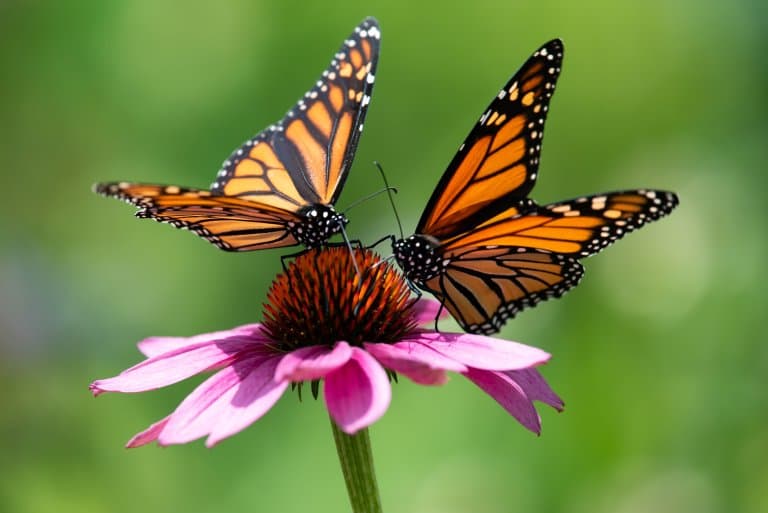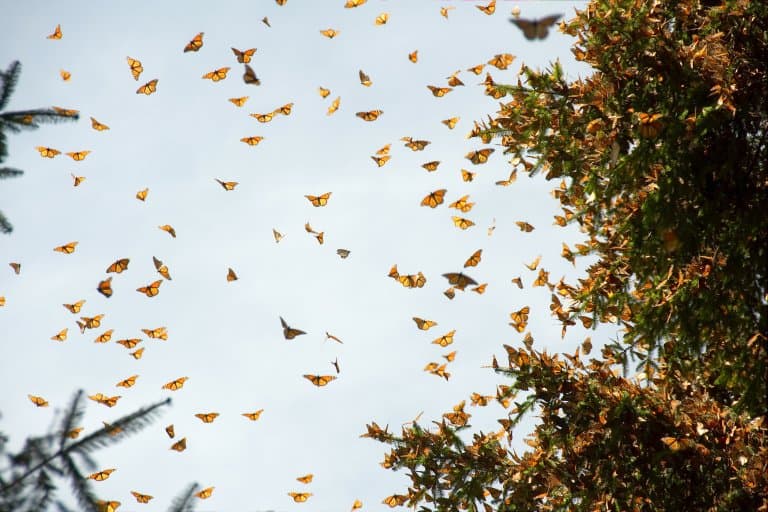Monarch Butterfly Profile
One of the most impressive annual migrations comes from an animal that’s no heavier than a sunflower seed.
The monarch butterfly has provided researchers with a whole bunch of fascinating questions and contributed to the wealth of scientific knowledge almost as much as the invaluable fruit fly.
The monarch is a milkweed butterfly and sometimes known as ‘milkweed’, common tiger or the wanderer in different regions. They have western and eastern populations, with ranges in the Americas, through to Australasia, Asia and Europe. Occassionally they will even appear in the UK.

Monarch Butterfly Facts Overview
| Habitat: | Forest, Shrubland, Grassland, Wetlands (inland). |
| Location: | The Americas, Europe, Australasia, North Africa, SE Asia |
| Lifespan: | Up to a few months |
| Size: | 8.9 to 10.2 cm (3.5 to 4 inches) |
| Weight: | Up to 0.75 grams (0.026 ounces) |
| Colour: | Bright orange wings with black veins and white spots |
| Diet: | Nectar from various flowers; caterpillars feed on milkweed |
| Predators: | Birds, spiders, wasps, and other insect-eating animals |
| Top Speed: | 9 km/h (6 miles per hour) |
| No. of Species: | 1 |
| Conservation Status: | Least Concern (IUCN) |
Monarchs are more widespread than many people realise, and there are countless, less interesting subpopulations all over the tropical world.
But the ones we all love to hear about are those that defy convention and even put many bird species to shame with their incredible migratory trips.
Not only are these migrations exceptional in distance, but they’re also a biological miracle of genetic navigation, physiological variation in a single species, and a fantastic, high-profile excuse to make our ecosystems healthier.
Interesting Monarch Butterfly Facts
1. They’re widespread
There’s been a lot of talk about the Monarch and its desperate need of help, and in some populations, this may be a real issue.
Climate change, pesticides and illegal logging are threatening migratory populations in the Americas, and some are now considered endangered, but the species as a whole is listed by the IUCN as of Least Concern.
This is a species that has become incredibly widespread across most of the tropical world, having set up homes wherever they were introduced by accident during the golden age of piracy. Now, they have populations on every continent except Antarctica, and this gives them a good chance of survival, even if the most common and popular communities are in a tragic decline.
There’s even some debate about the urgency of their peril in these populations too. One of the reasons they’re so hard to understand is the complexity of their lifecycle. 1

2. The caterpillars gather toxins
Monarch butterflies feed on nectar from several different flowers, but the larvae are more discriminating. The very hungry caterpillars prefer milkweed and are common on at least 25 different species in the Asclepius (milkweed) genus.
This narrow preference is due to the highly effective defences that the caterpillar can form while feeding on these plants. Milkweed contains toxins known as cardiac glycosides, which in human heart medicine are a fantastic thing, but in the culinary pursuit of monarchs, not so much.
These compounds affect the heart of vertebrates, and the plant manufactures them to avoid herbivory by animals like mammals, who would otherwise destroy them. Unfortunately for the plant, the caterpillar of the monarch has evolved a tolerance to this poison and therefore can eat the plant, storing the poison for its own defence against vertebrates. 2
3. They can control how much poison they store
Potential predators of the caterpillars are put off by the foul taste of these organic chemicals, which accumulate inside the larva to varying degrees.
The caterpillars are so good at regulating the amount of poison they need that they will either concentrate it if the plant doesn’t have a lot, or throw the surplus back up if there’s too much.
Those living on plants with lower concentrations of toxins look very much like those who live on plants with lots of toxins, which makes it hard for predators to know which ones are palatable. 3

4. Butterflies can live for as little as 2 weeks
During mating season, these butterflies have more or less one task to accomplish, and fit individuals will do so multiple times.
These shorter-lived butterflies have a limited amount of time to get the job done – usually around five or six weeks – after which they will die. This entire process can be as short as 2 weeks in the adult stage and is usually no more than six.
Females may lay up to 1200 eggs in this time – potentially her own mass in eggs! 4
5. Moarch butterflies can travel 4,500km (2,800 miles) in migration
The Monarchs are well known for being tremendous travellers, and this is particularly true for populations in North America.
Not all populations of this species move at all, but these are the most ambitious, taking part in a long-distance, two-way trip from the Northern US and Canada in the summer down to as far as California and even Mexico in the Winter.
Monarchs like this will travel up to 4,500km (2,800 miles), on a journey that will span three or four generations, and then gather in their tens to hundreds of millions in overwintering sites, in huge social clumps where they’ll hibernate.
Unlike their breeding-season counterparts, these migratory butterflies will put mating on hold to embark on their trip, which can take several weeks. 5
6. Their grandchildren will complete the return leg
After hibernating for up to four months, they start breeding again as temperatures begin to rise. This is the generation that will begin the trip back to the North, but they will never arrive.
Instead, subsequent generations will pick up where they left off, gradually repopulating the North and recolonising their feeding grounds.
It will take at least two more generations to make it all the way back, and they may be using different cues to do so.
At the peak of their migration, a Monarch butterfly may travel up to 426km miles in a single day!
7. They have an incredible genetic clock
When you break it down, this journey is baffling. Unlike migratory animals such as birds, who travel back and forth as individuals from the same place at the same time, year after year, these butterflies are different individuals at different stages of the process.
The ones born in the breeding months are not the same generation as those who embark on the epic migration, and the ones who migrate back are different still.
This means they each have a different instinctual understanding of where they need to go. Incredibly, researchers are beginning to understand how this feat is accomplished.
These butterflies have an incredible in-built understanding of seasons and the phases of the sun in the Northern Hemisphere. Internally, they have what’s known as a Time-Compensated Sun Compass, which is used as a clock to measure the seasons.
Using their eyes, they can not only record the position of the sun as it changes over the course of the year but also pick up on differences in the polarization of this light.
Internally, they have one of the most accurate biological clocks known, and by referencing this against the information they gather with their eyes, they’re able to use the sun to navigate directly South, no matter the time of day or the season.
Once in the South, the cold temperatures of their wintering sites function to biologically reverse this clock, giving them the roadmap for the return journey.

8. Monarch butterflies are the first to have their genome sequenced
Researchers sequened the 273-million-base pair draft sequence which includes a set of 16,866 protein-coding genes.
This has provided unique insights into their migratory behaviour, their genetic clock and microRNAs in populations.
While their is no genetic difference between migratory and non-migratory populations monarch butterlies, some microRNAs are expressed in migrating monarchs, but not expressed in nonmigrating monarchs.
9. The migratory subspecies in the Americas are endangered
As mentioned, the migratory subspecies in the Americas are now classified as endangered.
Common threats to this population include vast habitat loss at both ends of their migratory path, parasites, invasive plant species and climate change.
But their plight is not fully understood. Those 1,200 eggs that females can lay go a long way to repopulating losses, and records of their numbers are poorly kept. Still, their protection acts as a flagship cause for conservation, and while their needs may not be well known, their protection helps many other species, too.
10. Monarchs are good leaders
Unlike the unelected spongers in human societies, the charitable upkeep of monarch butterflies is good for the community as a whole.
Reducing herbicide and pesticide use, promoting Monarch ‘waypoints’ and designing roadway corridors for the butterflies to safely pass have a cascade of effects that promote biodiversity in the surrounding areas.
Promoting pollinator space in general works wonders for ecosystems, so regardless of the legitimacy of the Monarch’s plight, its protection is a good thing for all concerned.

Monarch Butterfly Fact-File Summary
Scientific Classification
| Kingdom: | Animalia |
| Phylum: | Arthropoda |
| Class: | Insecta |
| Order: | Lepidoptera |
| Family: | Nymphalidae |
| Genus: | Danaus |
| Species: | Danaus Plexippus |
Fact Sources & References
- JUSTIN OLSVIK (2022), “Are Monarch Butterflies Really in Peril?”, Slate.
- (1988), “Novel aspects of insect-plant interactions”, Internet Archive.
- (1988), “Allelopathic agents, Insect-plant relationships”, J. Wiley.
- “The Life Cycle of the Monarch Butterfly”, Monarch Butterflies.
- Steven M.Reppert (2018), “Demystifying Monarch Butterfly Migration”, Current Biology.
